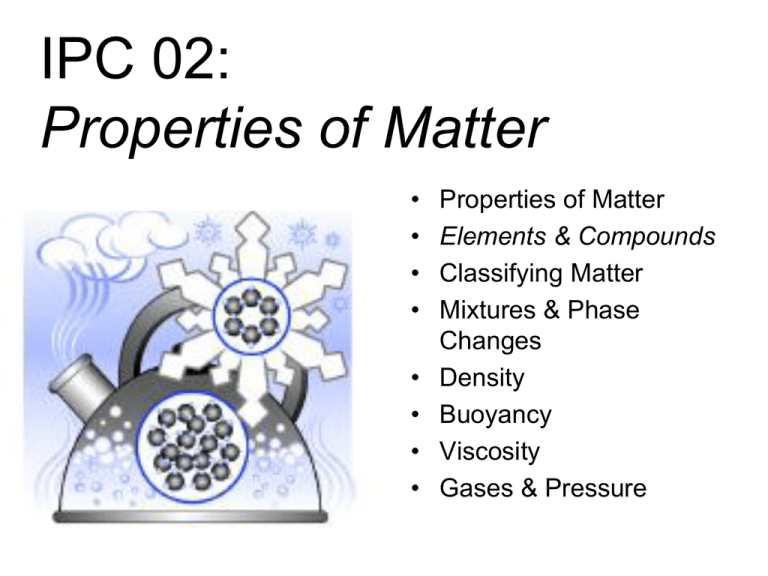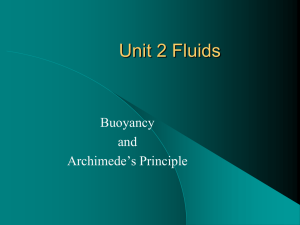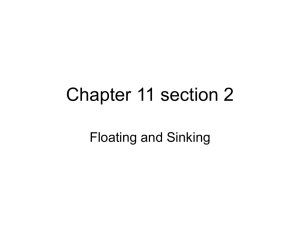Unit 2 Student Notes
advertisement

IPC 02: Properties of Matter • • • • • • • • Properties of Matter Elements & Compounds Classifying Matter Mixtures & Phase Changes Density Buoyancy Viscosity Gases & Pressure Matter is anything that has 1. Mass is the amount of ____________ an object has. 2. Volume is the amount of __________ an object takes up. • Question: Will an inflated balloon weigh more, less, or the same as the same balloon deflated? • Make a hypothesis, then test it. • Obtain the mass of a balloon, then inflate it, and then obtain the new mass. Pure Substances: • Compounds – made from more than ___________________ – A _________________ is the smallest particle of a compound that retains its properties. – Compounds cannot be separated by ___________________ Ex: salt, distilled water, sugar • Elements – made of only one kind of ___________________. – An atom is the __________ part of an element). Ex: Mixtures: contain _______________________ of matter and are physically combined. • Homogeneous Mixture • Heterogeneous Mixture • ________________ (same) throughout in composition • ________________(different) throughout in composition • Examples: coffee air (mixture of gases) • _________________like: brass (Cu & Zn) steel (Fe & C) • Examples: sand in water tea with ice cubes oil in water chicken noodle soup – (__________________) Separation of Mixtures Mixtures can be separated by _____________________________ a) b) c) d) e) Filtration Centrifuge Chromatography Distillation Crystallization Compounds can be separated by ___________________________ Examples: a) __________________ of water water hydrogen gas and oxygen gas b) _________________________ Magnesium + Acid hydrogen gas Mg + HCl (acid) MgCl2 + H2 Classify Matter Element, Compound, Homogenous mixture, or Heterogeneous mixture Boric Acid Solution Oxygen gas (O2) Carbon monoxide (CO) Steel (Carbon, Iron) Casserole Properties of Matter Property – _________________________ Physical properties: • characteristics that can be observed or measured ____________________ _________________ the identity of the substance. • Brainstorm a list of physical properties as a group. Hint: Think of gasoline! Chemical properties: • characteristics of a substance’s “_________” to change into a ____________________. • Brainstorm a list of chemical properties as a group. How many properties did you come up with? Physical density melting point hardness boiling point luster freezing point solubility viscosity elasticity brittleness magnetism malleability odor ductility color tensile strength solid electrical liquid conductivity gas Chemical combustibility flammability reactivity pH (acidity) Ex: States of Matter (Phases) Phase Shape Volume Fluidity Solid Liquid Gas Plasma – “___________________”. Plasma • Plasma is a gas containing charged particles such as ____________________ and _________________ • It is the ______________ ____________________ of matter in the universe. Changes of State Physical Properties Hardness luster – Solubility – Elasticity – Which would you rather play “basketball” with? A) bowling ball B) volleyball Physical Properties Brittleness – Malleability – Ductility – Tensile Strength – Chemical Properties CombustibilitY & Flammability – pH – reactivity – Changes of Matter Physical Changes: • A change that _________________ produce a new substance. • Usually _________________. • Ex: Chemical Changes: • A change that _________ produce a new substance. • Usually __________ reversible. • Ex: Phase Change: • ______________________ influences changes of state. • Endothermic: – Melting: – Boiling: – Sublimation: • Exothermic: – Condensation: – Freezing: – Deposition: The Phase Change Graph 1. Phase changes require a gain or loss of _______? 2. When does it gain energy? 3. When does it lose energy? Temp is constant. 4. At what points does the temperature stay the same? 5. Can two states coexist? Real World Experiences! • How does it feel when you put rubbing alcohol on your skin? Why? • What happens to “dry ice” when left on the counter? Why? • What happens to “moth balls” left in storage trunks? Critical Point – Gas & Liquid are indistinguishable The Phase Diagram On the line, ____________ coexist! Temperature Practice 1. 2. Pressure/bar B 3. C 4. 5. 3 6. 300 Temp/K What does point A represent? What area does 1, 2, and 3 represent? What is the state of the substance at 250K & 100 bar? Which state(s) of matter exist at: point A? Which state(s) of matter exist at: point B? Which state(s) of matter exist at: point C? Dry Ice Lab: “Simply Sublime” Dry Ice is particularly useful for freezing, and keeping things frozen because of its very cold temperature: -109.3°F or -78.5°C. CAUTION: NEVER pick up dry ice with your bare hands! Wear gloves & goggles! How do you know a chemical change has occurred? Evidence of a Chemical Change: 1. Energy (Heat): absorbed energy (________________________) released energy (________________________) 2. ______________ is produced (bubbles) 3. Solid (_______________) forms 4. ___________ or _____________ change occurs Physical change begins in the mouth Identify the following as a physical property, a chemical property, a physical change, or a chemical change. Ice melting Tarnishing in moist air Silver in color Conducts electricity Ability to explode Recycled aluminum can Ability to react with acid Burned the popcorn Mass vs. Volume • Which has more mass? A) 1 kilogram of feathers B) 1 kilogram of bricks • Which takes up more space? A) 1 kilogram of feathers B) 1 kilogram of bricks Measure matter by finding the density! Which has the greater density? A) steel bar B) steel paper clip Density of Steel steel bar Units for Density Metric Units: Solid: Liquid: Density of water is ______(at 4º C) Which one floats? Why? • Density of Water: 1.00 g/mL • Density of Ice: 0.92 g/mL Which of the following will float on water? Why is it good to know the density? Predict the correct “floating order” of the substances as they would appear in the “Density Column”. Substance Density g/cm3 Copper Corn oil Corn syrup 8.8 0.925 1.38 Glycerin Mercury Plastic Rubber Tar Water Wood 1.26 13.6 0.93 1.34 1.02 1.00 0.7 Why does a block of steel sink, but a steel boat float? The Titanic Sinks What two forces are involved? is the tendency for a ___________ dense substance to float in a _______________ dense substance. The__________________ ___________________ exerted on an object immersed in a fluid is called the “___________________ __________________”. Draw a vector to show the buoyant force (up) and the weight force (down). Weight Force (Gravity) Buoyant Force Which liquid exerts a greater buoyant force on the block? Blue or Clear? When will an object sink or float? Sink Float • Weight Force ___Buoyant Force • Weight Force ____ Buoyant Force • Density of object ____ density of fluid • Density of object ____ density of fluid Archimedes Principle The buoyant force exerted on an object in a fluid is ________________________ to the weight of the fluid displaced by the object. It explains: the buoyancy of ____________ the _________________ of a balloon in the air the loss of ________________ of objects underwater. 2N 2N Archimedes’ Principle Practice: • Rock weighs _________ • In water, the rock weighs ________________ • The water displaced by the rock: • So, the buoyant force exerted on the rock is ____________________ 0.45 N Do all fluids exert the same buoyant force on an object? Which liquid exerts a greater buoyant force? Buoyancy and Fluid How do Submarines work? Buoyancy and Gases Why do hot air balloons float? • A balloon will float when the weight of the balloon is _________ ______________ the weight of the volume of air displaced. • Air in the balloon is heated to make it __________________ than the surrounding air. Which flows slower? Ketchup or Molasses? Viscosity is the due to: • Large, bumpy __________________ • Strong _____________ between particles. How does temperature affect viscosity? • As a liquid gets warmer, its viscosity _________________ • As a gas gets warmer, its viscosity _______________. • Ex: • Why?





